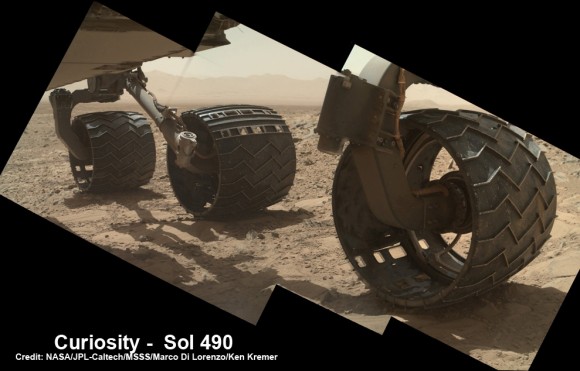
Dec 28
Rough Red Planet Rocks Rip Rover Curiosity Wheels
Photomosaic shows new holes and tears in several of rover Curiosity’s six wheels caused by recent driving over sharp edged Martian rocks on the months long trek to Mount Sharp. Raw images taken by the MAHLI camera on Curiosity’s arm on Dec. 22, 2013 (Sol 490) were assembled to show some recent damage to several of its six wheels – most noticeably the two here in middle and front. Credit: NASA / JPL / MSSS / Marco Di Lorenzo / Ken Kremer- kenkremer.com
Rough edged rocks on the Red Planet are clearly taking their toll on rover Curiosity’s hi tech wheels as she speeds towards her ultimate goal – humongous Mount Sharp – in search of the ingredients necessary to sustain potential Martian microbes.
Several of the NASA rovers six big aluminum wheels have suffered some significant sized rips, tears and holes up to several centimeters wide – in addition to numerous dents – as she has picked up the driving pace across the rugged, rock filled Martian terrain this past fall and put over 4.5 kilometers (3 mi.) on the odometer to date.
It’s rather easy to spot the wheel damage to the 1 ton behemoth by examining the mosaic imagery we have created – See above and below – from newly transmitted raw imagery and comparing that to older imagery taken at earlier points in the mission. Check our Sol 177 wheels mosaic below.
Dec 23
NASA Releases New Earthrise Simulation Video | NASA
NASA has issued a new visualization of the events leading to one of the iconic photographs of the 20th Century – Earth rising over the moon captured by the crew of the Apollo 8 mission.
This Lunar Orbiter 1 image of Earth, restored by the Lunar Orbiter Image Recovery Project, was sent by laser communications to the LADEE spacecraft in lunar orbit in Nov. 2013
Image Credit: NASA / LOIRP
The photo known as Earthrise is the first color photograph of Earth taken by a person in lunar orbit. Earthrise is the cover photo of TIME’s Great Images of the 20th Century, and is the central photo on the cover of LIFE’s 100 Photographs That Changed the World.
Earthrise had a profound impact on our attitudes toward our home planet, quickly becoming an icon of the environmental movement,” says Ernie Wright, project lead with the Scientific Visualization Studio at NASA’s Goddard Space Flight Center in Greenbelt, Md.
The visualization clearly shows how Apollo 8 Commander Frank Borman and crew members William A. Anders and James A. Lovell worked together to photograph the stunning scene as their spacecraft orbited the moon on Dec. 24, 1968. The video allows anyone to virtually ride with the astronauts and experience the awe they felt at the vista in front of them.
via NASA Releases New Earthrise Simulation Video |



